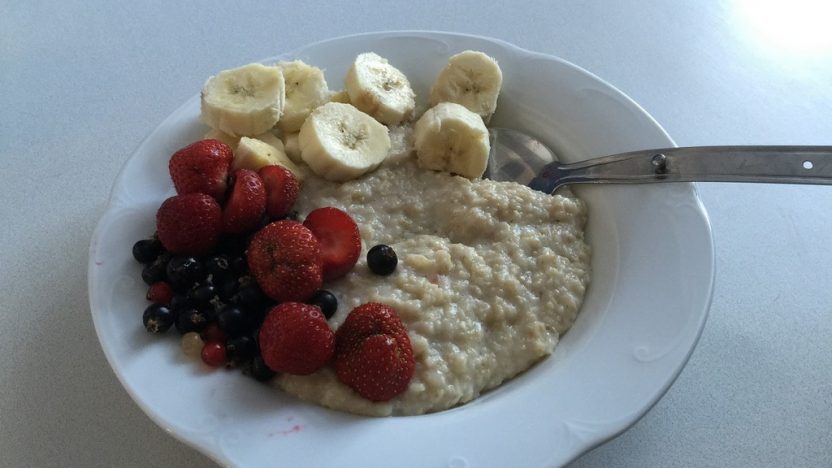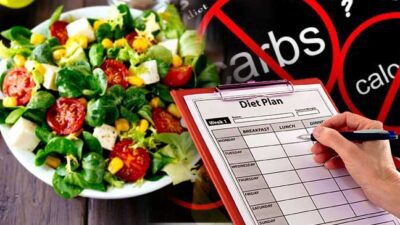Oatmeal is a classic breakfast staple enjoyed around the world for its heart-healthy benefits, versatility, and comforting texture. Whether it’s a quick and easy meal or a hearty, nutrient-dense bowl to start your day, oatmeal is often seen as one of the healthiest ways to fuel your body. However, if you are conscious of your calorie intake, you might be wondering: how many calories are in oatmeal?
In this detailed blog post, we will explore the calorie content of oatmeal, the factors that influence its nutritional value, and the many health benefits of including oatmeal in your diet. From traditional oats to the various toppings you can add, let’s dive into the world of oatmeal and learn more about how it fits into a balanced, healthy diet.
What is Oatmeal and Why is it So Popular?
Oatmeal is made from oats, a whole grain that is considered one of the healthiest grains you can consume. The oats used in oatmeal are often processed in different ways, such as rolled oats, steel-cut oats, or instant oats, but all forms of oatmeal offer impressive nutritional benefits. Oatmeal is most commonly prepared by cooking oats in water or milk, resulting in a warm, creamy bowl of goodness.
Oatmeal’s popularity stems from its heart-healthy properties, rich fiber content, and ease of preparation. It can be customized with a variety of toppings and flavorings, making it suitable for anyone’s taste preferences. Furthermore, it’s widely regarded as a nutrient-dense option that supports overall health and wellbeing.
Calories in Oatmeal: How Many Calories Does it Have?
The calorie content of oatmeal largely depends on the portion size, the type of oats used, and the ingredients you add to it. Plain, unflavored oatmeal is relatively low in calories, but the addition of milk, sugar, honey, fruit, or other toppings can significantly increase the calorie count.
Let’s break down the calories in different types of oatmeal and serving sizes to better understand how they fit into your diet.
1. Plain, Uncooked Rolled Oats (1/2 Cup)
Rolled oats are one of the most common types of oats used for making oatmeal. A 1/2 cup (about 40 grams) of plain, uncooked rolled oats contains:
- Calories: 150
- Carbohydrates: 27g
- Protein: 5g
- Fat: 3g
- Fiber: 4g
- Sugar: 0g
Rolled oats are a great base for oatmeal, as they provide a good amount of fiber and protein while being relatively low in calories. With only 150 calories per half-cup serving, they make an excellent foundation for a nutritious meal.
2. Cooked Oatmeal (1 Cup)
When you cook oats in water or milk, the calorie content will change depending on the liquid used. Here’s the breakdown for 1 cup of cooked oatmeal made with water:
- Calories: 150
- Carbohydrates: 27g
- Protein: 5g
- Fat: 3g
- Fiber: 4g
- Sugar: 0g
Cooking oats in water doesn’t add any calories, so 1 cup of plain, cooked oatmeal is about 150 calories. However, if you use milk or add sugar or toppings, the calorie count will increase.
3. Oatmeal Made with Milk (1 Cup)
If you cook your oatmeal with milk instead of water, the calorie content will be higher due to the calories in the milk. For example, a 1-cup serving of cooked oatmeal made with whole milk (about 240 ml) contains:
- Calories: 230-250
- Carbohydrates: 27g
- Protein: 9g
- Fat: 8g
- Fiber: 4g
- Sugar: 12g (from milk)
The use of milk adds extra calories, protein, and natural sugars. If you’re aiming for a creamier oatmeal with more protein, using milk can be a great option. You can also use lower-fat or plant-based milks, such as almond milk or oat milk, to adjust the calorie content according to your preferences.
4. Instant Oats (1 Packet)
Instant oats are a convenient option that cooks quickly but may have added sugar or preservatives. A typical packet of instant oatmeal (about 28-30 grams) contains:
- Calories: 150-200 (depending on the brand and flavor)
- Carbohydrates: 30g
- Protein: 4g
- Fat: 3g
- Fiber: 3g
- Sugar: 10-15g (depending on whether it’s flavored)
Instant oats are often pre-sweetened, which contributes to the higher calorie content. If you’re looking for a low-calorie option, it’s important to choose plain instant oats or those without added sugars.
5. Steel-Cut Oats (1/4 Cup Uncooked)
Steel-cut oats are less processed and offer a chewier texture compared to rolled oats. A 1/4 cup (about 40 grams) of uncooked steel-cut oats contains:
- Calories: 150
- Carbohydrates: 27g
- Protein: 5g
- Fat: 3g
- Fiber: 4g
- Sugar: 0g
Steel-cut oats are very similar in calorie content to rolled oats but take longer to cook. However, they tend to retain a firmer texture and provide a richer, nuttier flavor.
How Additions to Oatmeal Affect Its Calorie Content
Oatmeal is a highly customizable dish, and the toppings or mix-ins you add can significantly impact the calorie count. Let’s look at how various ingredients can influence the overall nutritional profile of your oatmeal.
1. Sweeteners: Honey, Maple Syrup, and Sugar
Adding sweeteners to your oatmeal is one of the most common ways to enhance its flavor. However, these additions increase the calorie count:
- 1 tablespoon of honey: 60-70 calories
- 1 tablespoon of maple syrup: 50-55 calories
- 1 tablespoon of sugar: 45-50 calories
While these sweeteners add delicious flavor, they also increase the calorie content, so use them sparingly if you’re looking to keep your oatmeal low-calorie.
2. Fruits: Fresh and Dried
Fresh fruit can add natural sweetness and nutrients to your oatmeal. Some common fruits and their calorie counts include:
- 1/4 cup of blueberries: 20-25 calories
- 1/2 banana (medium): 50-60 calories
- 1/4 cup of strawberries: 10-15 calories
- 1/4 cup of raisins: 100-110 calories
Fresh fruits like berries, bananas, and apples are great low-calorie toppings that add fiber, vitamins, and antioxidants to your meal. However, dried fruits tend to be more calorie-dense, so be mindful of portion sizes.
3. Nuts and Nut Butters
Nuts and nut butters are excellent sources of healthy fats and protein, but they also contribute to the calorie content:
- 1 tablespoon of almond butter: 90-100 calories
- 1 tablespoon of peanut butter: 95-105 calories
- 1/4 cup of almonds: 130-150 calories
Adding nuts or nut butters to your oatmeal can make it more filling and nutritious, but keep an eye on the serving sizes to avoid consuming too many extra calories.
4. Dairy or Plant-Based Milk
The type of milk you use to prepare your oatmeal also affects its calorie count. For example:
- 1 cup of whole milk: 150 calories
- 1 cup of skim milk: 90 calories
- 1 cup of almond milk: 30-40 calories
- 1 cup of oat milk: 120 calories
For a lower-calorie option, you can use unsweetened plant-based milks like almond or coconut milk. If you prefer a creamier texture, go for oat or soy milk, but keep in mind that these options tend to be slightly higher in calories.
Health Benefits of Oatmeal
Oatmeal is not only low in calories but also packed with numerous health benefits, making it an excellent choice for breakfast or a meal throughout the day.
1. Supports Heart Health
Oats are rich in beta-glucan, a type of soluble fiber that has been shown to help lower cholesterol levels. Studies suggest that regularly eating oatmeal can reduce the risk of heart disease by lowering both LDL (bad) cholesterol and blood pressure.
2. Regulates Blood Sugar Levels
The soluble fiber in oatmeal can also help regulate blood sugar levels, making it a great option for people with diabetes or those looking to manage their blood sugar. The fiber slows down the absorption of sugars, preventing spikes in blood glucose levels.
3. Boosts Digestive Health
The fiber in oatmeal promotes regular bowel movements and improves overall digestive function. It can also help prevent constipation and promote a healthy gut microbiome.
4. Supports Weight Loss
Oatmeal’s high fiber content helps you feel full for longer periods of time, reducing overall calorie consumption throughout the day. Because oatmeal is low in calories but high in fiber, it makes for a great meal choice for those looking to lose or maintain weight.
5. Provides Long-Lasting Energy
The complex carbohydrates in oatmeal provide a steady and sustained release of energy, helping to keep you feeling energized throughout the morning. This makes oatmeal a perfect choice for breakfast, giving you the fuel you need to start your day strong.
Conclusion: Calories in Oatmeal
Oatmeal is a delicious, nutritious, and versatile meal that offers numerous health benefits. The calorie content of oatmeal depends on the type of oats used and any added ingredients or toppings. On its own, a bowl of plain oatmeal made with water contains only about 150 calories per cup. However, depending on the toppings and liquids you use, the calorie content can vary.
Regardless of the calorie count, oatmeal remains one of the healthiest and most satisfying meals you can eat. Whether you’re looking to lose weight, regulate your blood sugar, or simply enjoy a filling and nourishing breakfast, oatmeal is an excellent choice.
Key Takeaway: Oatmeal is a low-calorie, nutrient-dense meal that provides a variety of health benefits. By choosing your ingredients wisely and controlling portion sizes, oatmeal can be part of a balanced, healthy diet that supports overall wellbeing.




